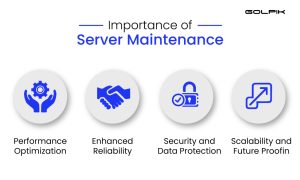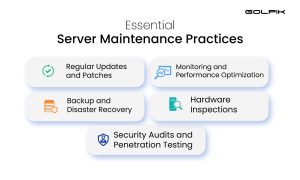Server maintenance is a crucial aspect of managing a computer network. It involves a series of tasks and processes that ensure the server software is updated and running smoothly, avoiding downtime or loss of data. Regular server maintenance is essential to keep the server running as expected and to help avoid a total or partial network failure. This blog will explore the basics of server maintenance, including its importance, its importance, and how to implement a server maintenance plan. We will also discuss the essential components of a server maintenance plan, such as hardware component replacement, software installation and updates, memory and processor usage oversight, and maintaining server backups to facilitate data retrieval in case of failures. Whether you are a server administrator or a website operator, this blog will provide valuable insights into server & website maintenance and help you keep your server running smoothly.
What is Server Maintenance?
Server maintenance refers to keeping servers in good health by performing necessary tasks, updates, and optimizations. It involves various activities, from routine checks to addressing potential issues and applying software patches. The primary goals of server maintenance are to enhance performance, ensure uptime, mitigate security risks, and extend the overall lifespan of the server infrastructure.
The Importance of Server Maintenance:

Performance Optimization:
Regular application maintenance and support coupled with a tight website maintenance checklist for websites helps identify and resolve performance bottlenecks, ensuring servers operate at their peak efficiency. This includes monitoring resource utilization, optimizing configurations, and fine-tuning software settings. By proactively managing server performance, businesses can provide a better user experience, reduce response times, and handle higher workloads efficiently.
Enhanced Reliability:
By proactively addressing potential issues, such as hardware failures or software glitches, server maintenance minimizes the risk of unexpected downtime. This is particularly critical for businesses and organizations that rely heavily on their online presence to serve customers and conduct operations. Downtime can lead to lost revenue, damage to reputation, and decreased customer satisfaction. Regular maintenance practices like monitoring system health, detecting failures, and implementing redundancy measures help ensure high availability and reliability.
Security and Data Protection:
Servers are prime targets for cyber-attacks and data breaches. Server maintenance involves implementing security measures like updating software, applying security patches, and configuring firewalls to safeguard against vulnerabilities and protect sensitive data. All of these come in mobile application maintenance. Regular security audits and vulnerability assessments can identify weaknesses in the server infrastructure, allowing administrators to address them promptly. Additionally, implementing robust backup and disaster recovery strategies ensures that critical data is protected and can be restored in case of a breach or accidental data loss.
Scalability and Future Proofing:
Server maintenance includes capacity planning to accommodate increasing demands. Regular assessments and upgrades ensure the server infrastructure can handle growing workloads and evolving technologies, preventing performance degradation. By monitoring resource usage and planning for future needs, businesses can scale their server infrastructure effectively, avoiding performance bottlenecks and costly infrastructure changes.
Essential Server Maintenance Practices:

Regular Updates and Patches:
Stay up-to-date with the latest software updates, security patches, and firmware upgrades provided by the server manufacturer or software vendors. These updates often address known vulnerabilities and provide important performance enhancements. Keeping the server software and firmware updated helps protect against security threats, improves stability, and ensures compatibility with new technologies.
Monitoring and Performance Optimization:
Employ server monitoring tools to keep track of key performance metrics like CPU usage, memory utilization, network traffic, and disk space. This enables the timely identification of issues and proactive optimization. Monitoring can help administrators detect resource bottlenecks, identify trends, and make informed decisions about capacity planning and performance optimizations. Administrators can fine-tune configurations, allocate resources efficiently, and optimize server performance by analyzing performance data.
Backup and Disaster Recovery:
Implement a robust backup strategy to protect critical data in the event of hardware failure, accidental deletion, or natural disasters. Regularly test the backup and disaster recovery processes to ensure their effectiveness. Backups should be performed regularly and stored securely in off-site locations or reliable cloud storage platforms. Regular testing of backup restoration procedures helps ensure that data can be recovered successfully when needed. In addition, developing a comprehensive disaster recovery plan that outlines the steps to be taken during a server outage or catastrophe is essential for minimizing downtime and ensuring business continuity.
Hardware Inspections:
Periodically inspect server hardware components to detect any signs of wear and tear. Check for dust accumulation, loose cables, or failing fans that could potentially lead to overheating or hardware failure. Regular hardware inspections and preventive maintenance can extend the lifespan of server hardware and reduce the risk of unexpected failures. Cleaning components and replacing faulty parts in a timely manner helps maintain the reliability and performance of the server infrastructure.
Security Audits and Penetration Testing:
Conduct regular security audits to assess vulnerabilities and risks. Perform penetration testing to identify potential weaknesses in the server infrastructure and remediate them before they are exploited. Security audits involve reviewing access controls, permissions, and user privileges and evaluating network configurations and encryption protocols. Penetration testing involves simulating real-world attacks to identify vulnerabilities and validate the effectiveness of security measures. By addressing vulnerabilities proactively, businesses can reduce the risk of data breaches, unauthorized access, and other security incidents.
Conclusion
Server maintenance is a crucial aspect of managing and optimizing server infrastructure. By investing time and resources into regular maintenance practices, businesses, and organizations can ensure their servers’ performance, reliability, and security. From application maintenance and support services from experts to following efficient website maintenance tasks, including security patches to hardware inspections and performance optimizations, server maintenance encompasses a wide range of activities that are essential for keeping servers running smoothly. By implementing a proactive maintenance strategy, you can minimize downtime, enhance security, and maximize the lifespan of your server infrastructure. A well-maintained server environment provides a stable and secure foundation for your online services and enables efficient scalability and future growth. Prioritizing server maintenance is key to building a robust and resilient IT infrastructure. If you’re looking for a top-tier app and website maintenance company, App Support Ninja has you covered! Get in touch to learn all about it!

